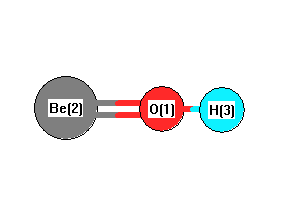Jump to
S1C2
Energy calculated at CCSD/cc-pVDZ
| | hartrees |
|---|
| Energy at 0K | -90.322593 |
| Energy at 298.15K | -90.322419 |
| HF Energy | -90.102578 |
| Nuclear repulsion energy | 17.245520 |
The energy at 298.15K was derived from the energy at 0K
and an integrated heat capacity that used the calculated vibrational frequencies.
Geometric Data calculated at CCSD/cc-pVDZ
Point Group is Cs
Cartesians (Å)
| Atom |
x (Å) |
y (Å) |
z (Å) |
|---|
| O1 |
0.054 |
-0.389 |
0.000 |
| Be2 |
0.054 |
1.039 |
0.000 |
| H3 |
-0.648 |
-1.039 |
0.000 |
Atom - Atom Distances (Å)
| |
O1 |
Be2 |
H3 |
| O1 | | 1.4281 | 0.9571 |
Be2 | 1.4281 | | 2.1936 | H3 | 0.9571 | 2.1936 | |
 More geometry information
More geometry information
Calculated Bond Angles
| atom1 |
atom2 |
atom3 |
angle |
|
atom1 |
atom2 |
atom3 |
angle |
| Be2 |
O1 |
H3 |
132.773 |
|
Electronic energy levels
Charges, Dipole, Quadrupole and Polarizability
Jump to
S1C1
Energy calculated at CCSD/cc-pVDZ
| | hartrees |
|---|
| Energy at 0K | -90.321623 |
| Energy at 298.15K | |
| HF Energy | -90.101967 |
| Nuclear repulsion energy | 17.466267 |
The energy at 298.15K was derived from the energy at 0K
and an integrated heat capacity that used the calculated vibrational frequencies.
Vibrational Frequencies calculated at CCSD/cc-pVDZ
| Mode Number |
Symmetry |
Frequency
(cm-1) |
Scaled Frequency
(cm-1) |
IR Intensities
(km mol-1) |
Raman Act
(Å4/u) |
Dep P |
Dep U |
|---|
| 1 |
Σ |
4146 |
3927 |
238.07 |
|
|
|
| 2 |
Σ |
1319 |
1249 |
114.35 |
|
|
|
| 3 |
Π |
222i |
210i |
161.38 |
|
|
|
| 3 |
Π |
222i |
210i |
161.38 |
|
|
|
Unscaled Zero Point Vibrational Energy (zpe) 2510.3 cm
-1
Scaled (by 0.9473) Zero Point Vibrational Energy (zpe) 2378.0 cm
-1
See section
III.C.1 List or set vibrational scaling factors
to change the scale factors used here.
See section
III.C.2
Calculate a vibrational scaling factor for a given set of molecules
to determine the least squares best scaling factor.
Geometric Data calculated at CCSD/cc-pVDZ
Point Group is C∞v
Cartesians (Å)
| Atom |
x (Å) |
y (Å) |
z (Å) |
|---|
| O1 |
0.000 |
0.000 |
0.358 |
| Be2 |
0.000 |
0.000 |
-1.042 |
| H3 |
0.000 |
0.000 |
1.306 |
Atom - Atom Distances (Å)
| |
O1 |
Be2 |
H3 |
| O1 | | 1.3991 | 0.9488 |
Be2 | 1.3991 | | 2.3480 | H3 | 0.9488 | 2.3480 | |
 More geometry information
More geometry information
Calculated Bond Angles
| atom1 |
atom2 |
atom3 |
angle |
|
atom1 |
atom2 |
atom3 |
angle |
| Be2 |
O1 |
H3 |
180.000 |
|
Electronic energy levels
Charges, Dipole, Quadrupole and Polarizability
